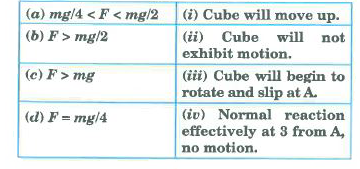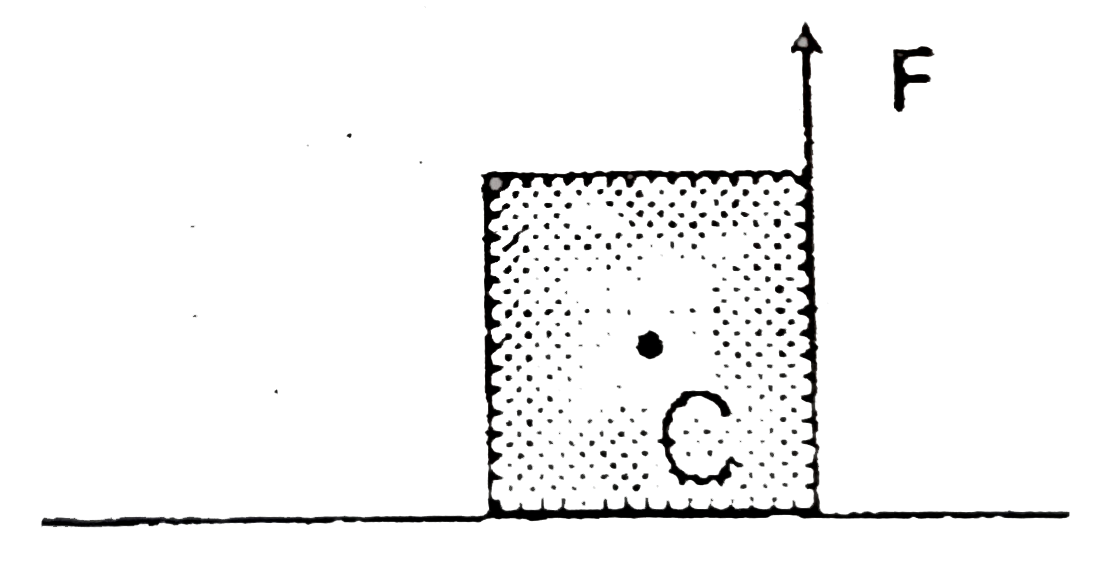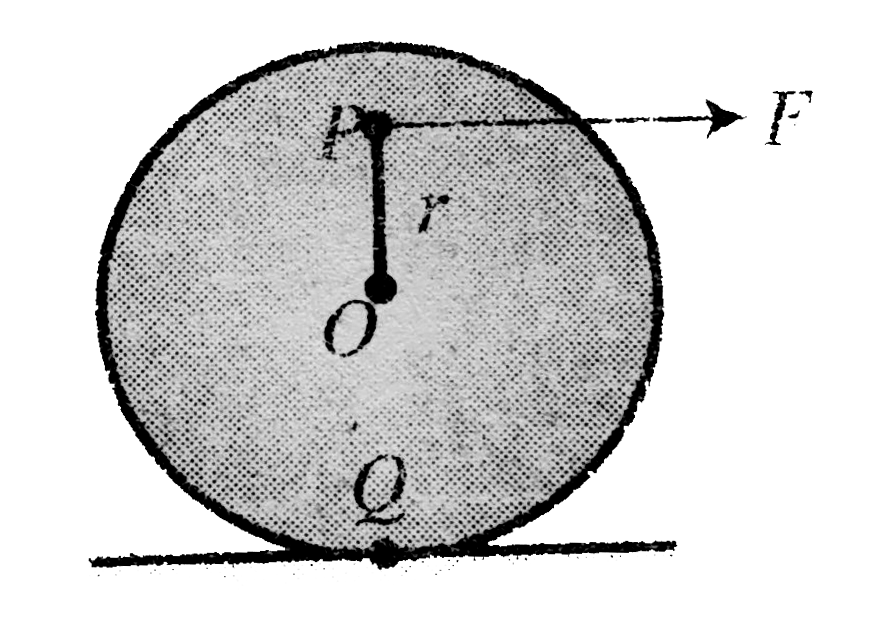A uniform cube of mass m and side a is placed on a frictionless horizontal surface. A vertical force F is applied to the edge as shown in Fig. Match the following (most appropriate choice) :
(a)mg/4<F<mg/2 (p) Cube will move up.
(b) F>mg/2 (q) Cube will not exhibit motion.
(c ) F>mg (r) Cube will begin to rotate and slip at A.
(d) F=mg/4 (s) Normal reaction effectively at a/3 from A, no motion.

A-p, B-q, C-s, D-r
A-r, B-s, C-q, D-p
A-q, B-r, C-p, D-s
A-s, B-p, C-r, D-q
The correct Answer is:C
From the figure, Moment of force F about a,
τ1=F×a, anticlockwise.
Moment of weight Mg of cube about A,
τ2=Mg×a2, clockwise.
The cube will not exhibit any motion, if τ1=τ2

or F×a=Mg×a2or F=Mg2
The cube will rotate only, when τ1>τ2
F×a>Mga2 or F>Mg2
If we assume that normal reaction is effective at a/3 from A, then block would turn if
Mg×a3=F×a or F=Mg3
When F=Mg4<Mg3, there will no motion.
Hence we conclude A-q, B-r, C-p, D-s.
Topper's Solved these Questions
- SYSTEM OF PARTICLES AND ROTATIONAL MOTIONSBook:NCERT FINGERTIPSChapter:SYSTEM OF PARTICLES AND ROTATIONAL MOTIONSExercise:Moment Of Inertia
Explore 7 Videos
- SYSTEM OF PARTICLES AND ROTATIONAL MOTIONSBook:NCERT FINGERTIPSChapter:SYSTEM OF PARTICLES AND ROTATIONAL MOTIONSExercise:Theorems Of Perpendicular And Parallel Axes
Explore 5 Videos
- SYSTEM OF PARTICLES AND ROTATIONAL MOTIONSBook:NCERT FINGERTIPSChapter:SYSTEM OF PARTICLES AND ROTATIONAL MOTIONSExercise:Torque And Angular Momentum
Explore 11 Videos
- PRACTICE PAPERSBook:NCERT FINGERTIPSChapter:PRACTICE PAPERSExercise:Practice Paper 3
Explore 50 Videos
- THERMAL PROPERTIES OF MATTERBook:NCERT FINGERTIPSChapter:THERMAL PROPERTIES OF MATTERExercise:Assertion And Reason
Explore 10 Videos
Similar Questions
A uniform cube of mass m and side a is placed on a frictionless horizontal surface. A vertical force Fis applied to the edge as shown in figure. Match the following (most appropriate choice).


View SolutionA unifrom cube of mass m and side a is placed on a frictionless horizontal surface .A vertical force F is applied to the edge as shown in figure ,match the following (most appropriate choice )

View Solution
Knowledge Check
A uniform cube of mass 4kg and side 30cm is placed on a fricitionless horizontal surface. A vertical force F is applied to the edge as shown in the figure. Choose the most appropriate option(s). (take g=10m/s2)
 ACube will move in the upward direction if F>40NBCube will not perform any type of translation or roataion motion if 10N<F<20NCCube will begin to perform rotational motion if 20N<F<40NDNormal reaction applied by the surface shifts to a distance 5cm from centre C of the cube if F=10N
ACube will move in the upward direction if F>40NBCube will not perform any type of translation or roataion motion if 10N<F<20NCCube will begin to perform rotational motion if 20N<F<40NDNormal reaction applied by the surface shifts to a distance 5cm from centre C of the cube if F=10NA uniform cube of mass m and edge a moves on a horizontal surface along the positive x-axis, with initial velocity v0. Then
ADuring motion , NgtmgBDuring motion, normal reactions acts on the center of massCduring motion, the normal reaction shifts towards positive x-axis from the center of massDduring motion, normal reaction shifts in the direction of the force of friction.A block of mass m is placed on a rough horizontal surface. If minimum force to pull the block is mg2 then coefficient of friction is :
A12B√3C1√3DNone
A unifrom cube of mass m and side a is placed on a frictionless horizontal surface. A vertical force F is applied to the edge as shown in Fig. Match the following (most appropriate choice) :
(a)mg/4<F<mg/2 (i) Cube will move up.
(b) F>mg/2 (ii) Cube will not exhibit motion.
(c ) F>mg (iii) Cube will begin to rotate and slip at A.
(d) F=mg/4 (iv) Normal reaction effectively at a/3 from A, no motion.

View SolutionA uniform disc of mass m, radius R is placed on a smooth horizontal surface. If we apply a horizontal force F at P as shown in the figure. If F=4N,m=.1kg,R=1m and r=12m then, find the:

acceleration of the CM (in ms2)
View SolutionA cube of edge 2 cm and mass 10 g is placed on the surface of a table. What is the pressure exerted by the cube on the table?
View SolutionA uniform disc of mass m, radius R is placed on a smooth horizontal surface. If we apply a horizontal force F at P as shown in the figure. If F=4N,m=.1kg,R=1m and r=12m then, find the:

angular acceleration of the disc. (rads−1)
View SolutionTwo particle A & B each of mass m are in equilibrium in a vertical plane under action of a horizontal force F=mg on particle B, as shown in figure Then :

View Solution

